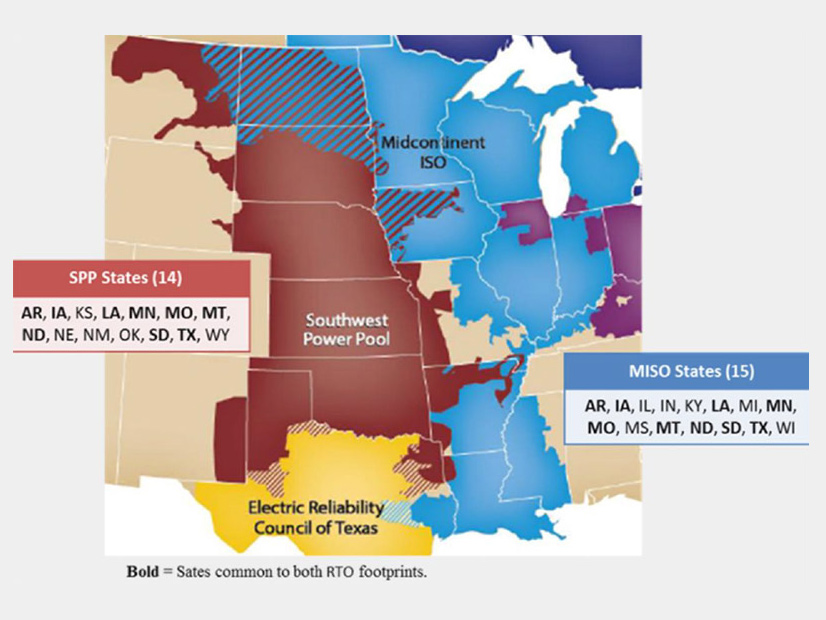MISO and SPP will begin a smaller interregional planning study this year along with their ongoing joint interconnection queue study, stakeholders learned this week.
The study will come in the form of a targeted market efficiency project (TMEP) approach instead of the usual coordinated system plan (CSP), the RTOs announced during Tuesday’s Interregional Planning Stakeholder Advisory Committee. TMEPs are smaller, congestion-relieving cross-border transmission projects already in use between MISO and PJM.
The grid operators last performed a CSP in 2020. Their joint operating agreement requires an interregional study no less than once every two years.
MISO and SPP have undertaken four CSP studies since 2014. Each time, their planners have come up empty in agreeing on beneficial projects despite increasing congestion at their seams. (See 4th Time No Charm for MISO-SPP Interregional Study.)
This year, however, the RTOs will juggle the TMEP study alongside the Joint Targeted Interconnection Queue (JTIQ) study, which last month rolled out a $1.755 billion portfolio of suggested projects. (See MISO, SPP Roll out $1.755B Joint Tx Portfolio.)
The JTIQ is meant to increase system capacity and ease the grid operators’ overcrowded interconnection queues amid shifting resource mixes. It was announced in 2020, around the time that the fourth CSP failed to produce an interregional project.
Missouri Public Service Commission economist Adam McKinnie said his commission appreciated the JTIQ study’s work but pointed out several congested areas remain along the MISO-SPP seam that could use more precise upgrades.
McKinnie and other state regulators have advocated for the smaller-scale TMEP study process for more than a year. (See MISO, SPP Regulators Call for Pancaking Fix, Smaller Projects.)
Evergy’s Katy Onnen asked that the interregional study modeling contain high wind generation scenarios, something the RTOs’ modeling doesn’t currently consider.
SPP’s Neil Robertson reminded stakeholders that the proposed JTIQ portfolio will likely resolve the need for some projects that might otherwise be pursued under a TMEP process.
“I want to remind everyone that we have multiple efforts working in parallel right now,” he said. “With multiple parallel efforts in the interregional planning sphere in play, there’s going to be some overlap.”
Robertson said MISO and SPP have yet to decide how they will model the JTIQ projects in the TMEP process.
“I just really hope you don’t consider the JTIQ a done deal,” McKinnie said, noting that its cost-allocation discussions are not very far along and imply that disagreements might derail projects.
“I’m fine with solutions competing against each other,” he said. “I just urge you to look at issues rather than say, ‘It’s in the JTIQ, therefore it’s a third rail that we can’t touch.’”
Robertson said staffs will not consider JTIQ projects as certainties to include in a base-case model for another interregional study.
Some stakeholders said MISO and SPP might want to pursue smaller TMEP fixes while waiting on big-ticket JTIQ projects’ construction.
The RTOs said they opted for a TMEP study over a CSP partly because neither is performing an economic study as part of their 2022 transmission planning. TMEPs don’t require staffs to conduct production cost modeling.
“We don’t have that synergy this year,” MISO engineer Ben Stearney explained.
Stearney said the grid operators have a framework “starting point, given the existence of the MISO-PJM TMEP.” He said the RTOs and their stakeholders will settle on a TMEP study scope and criteria throughout 2022. The process will be memorialized in their joint operating agreement.
PJM’s and MISO’s version of TMEPs must cost less than $20 million, be in service within three years of approval and, within four years of operation, provide congestion relief equal to or greater than the construction cost. MISO’s and SPP’s TMEP criteria could look different.
The grid operators also said the TMEPs’ targeted study style and smaller transmission projects will help ease their interregional workload, given the ongoing JTIQ. The study is not considered part of either a CSP or TMEP study.
“The reality is that developing the cost allocations around the JTIQ are going to be complex, and we don’t see that happening until 2023,” Stearney said.
MISO and SPP plan to schedule more joint planning meetings in the second quarter.




